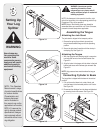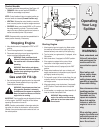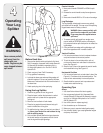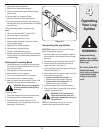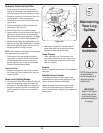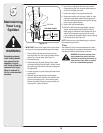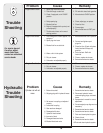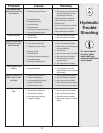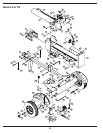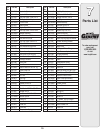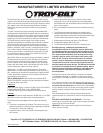
13
5
WARNING
IMPORTANT
Never hit the engine
shaft in any manner,
as a blow will cause
permanent damage to
the engine.
Maintaining
Your Log
Splitter
Hydraulic Fluid and Inlet Filter
• Check the hydraulic fluid level in the log splitter
reservoir tank before each use. Maintain fluid level
within the range specified on the dipstick at all times.
• Change the hydraulic fluid in the reservoir every 100
hours of operation. Follow the steps below:
1. Disconnect the suction hose from the bottom of the
reservoir tank.
2. Carefully unthread the inlet filter and clean it with
penetrating oil. See Figure 5-2.
3. Allow the fluid to drain into a suitable container.
4. Reinsert the filter and refill the reservoir with three (3)
gallons of oil. Approved fluids include Dexron® III /
Mercon® III automatic transmission fluid, a 10 Weight
AW hydraulic oil or Pro-Mix™ AW-32 Hydraulic Oil.
• Maintain fluid level within the range specified on the
dipstick at all times. When checking the fluid, always
make sure to tighten the dipstick until the top of the
threads are flush with the top of the pipe.
NOTE: Always dispose of used hydraulic fluid and engine
oil at approved recycling centers only.
• Contaminants in fluid may damage the hydraulic
components. Flushing the reservoir tank and hoses
with kerosene whenever service is performed on
the tank, hydraulic pump or valve is recommended.
Contact an authorized service dealer.
Hydraulic Filter
• Change the hydraulic filter every 50 hours of opera-
tion. Use only a 10 micron hydraulic filter. Order part
number 723-0405.
Beam and Splitting Wedge
• Lubricate both sides of the beam (where it comes into
contact with the splitting wedge), before each use,
with engine oil. The wedge plate on the log splitter is
designed so the gibs on the side of the wedge plate
can be removed and rotated and/or turned over for
even wear.
• Make certain to readjust the adjustment bolts so
wedge moves freely, but no excess space exists
between the wedge plate and the beam.
Hose Clamps
• Check, before each use, if hose clamps on the
suction hose (attached to the side of the pump) are
tight. Check the hose clamps on the return hose at
least once a season.
Engine
Refer to the separate engine manual for all maintenance
instructions.
Flexible Pump Coupler
The flexible pump coupler is a nylon “spider” insert,
located between the pump and the engine shaft. Over
time, the coupler will harden and deteriorate.
Replace the coupler if you detect vibration or noise
coming from the area between the engine and the
pump. If the coupler fails completely, you will experience
a loss of power.
Figure 5-2
NOTE: Always dispose
of used hydraulic
fluid and engine oil at
approved recycling
centers only.




